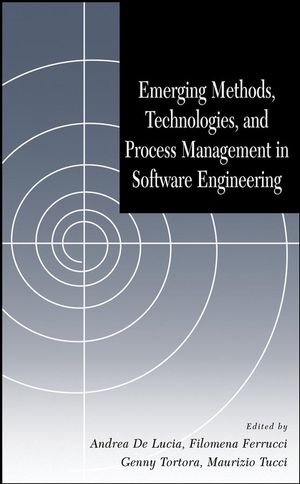Emerging Methods, Technologies, and Process Management in Software EngineeringISBN: 978-0-470-08571-4
Hardcover
283 pages
February 2008, Wiley-IEEE Computer Society Press
 This is a Print-on-Demand title. It will be printed specifically to fill your order. Please allow an additional 10-15 days delivery time. The book is not returnable.
|
||||||
PART I: SOFTWARE ARCHITECTURES.
1 EVOLUTION OF SOFTWARE COMPOSITION MECHANISMS: A SURVEY (Carlo Ghezzi and Filippo Pacifici).
1.1. Introduction.
1.2. Basic Concepts.
1.3. Early Days.
1.4. Achieving Flexibility.
1.5. Software Composition in the Open World.
1.6. Challenges and Future Work.
Acknowledgments.
References.
2 COMPOSITIONALITY IN SOFTWARE PRODUCT LINES (Christian Prehofer, Jilles van Gurp, and Jan Bosch).
2.1. Introduction.
2.2. From Integration-Oriented to the Compositional Approach.
2.3. Components and Architectural Slices.
2.4. Research Challenges of the Compositional Approach.
2.5. Summary.
References.
3 TEACHING DESIGN PATTERNS (Bernd Bru¨gge and Timo Wolf).
3.1. Introduction.
3.2. The Design of Asteroids.
3.3. Downloading and Executing Asteroids.
3.4. Exercise 1: Observer Pattern Modeling.
3.5. Exercise 2: Observer Pattern Programming.
3.6. Exercise 3: Adapter Pattern Modeling.
3.7. Exercise 4: Adapter Pattern Programming.
3.8. Exercise 5: Strategy Pattern Modeling.
3.9. Exercise 6: Strategy Pattern Programming.
3.10. Experiences and Conclusion.
References.
PART II: EMERGING METHODS.
4 ON THE IMPACT OF AOSE IN SERVICE-ORIENTED COMPUTING (Laura Bocchi, Paolo Ciancarini, Rocco Moretti, and Valentina Presutti).
4.1. Introduction.
4.2. Agent Systems and AOSE.
4.3. The Impact of Agents in Service-Oriented Architectures.
4.4. A Model-Driven Architecture of Services for Grid Agents.
4.5. Agent Coordination and Orchestration in the Web Service Architecture.
4.6. Ontological Approach for WSA.
4.7. Conclusions.
References.
5 TESTING OBJECT-ORIENTED SOFTWARE (Leonardo Mariani and Mauro Pezzè).
5.1. Introduction.
5.2. Impact of Object-Oriented Design on Testing.
5.3. Specification-Based Testing Techniques.
5.4. UML Intraclass Testing.
5.5. UML Interclass Testing.
5.6. Algebraic Testing Techniques.
5.7. Code-Based Testing Techniques.
5.8. Intraclass Structural Testing.
5.9. Interclass Structural Testing.
5.10. Testing in the Presence of Inheritance.
5.11. Regression Testing.
5.12. Conclusions.
References.
6 THE UML AND FORMAL METHODS: A CASE STUDY (Carlo Montangero).
6.1. Introduction.
6.2. A Biased View of the UML.
6.3. ForLySa.
6.4. Conclusions.
Acknowledgments.
References.
7 MODERN WEB APPLICATION DEVELOPMENT (Mehdi Jazayeri, Cédric Mesnage, and Jeffrey Rose).
7.1. Introduction.
7.2. Foundations of the Web.
7.3. Software Engineering and Web Applications.
7.4. Current Trends.
7.5. Future Directions.
7.6. Summary and Conclusions.
References.
PART III: TECHNOLOGIES FOR SOFTWARE EVOLUTION.
8 MIGRATING TO WEB SERVICES (Harry M. Sneed).
8.1. Forces Driving Migration.
8.2. The Emergence of Web Services.
8.3. Providing Web Services.
8.4. Web Service Mining.
8.5. Applying Wrapping Techniques.
8.6. Experience in the Field.
8.7. Conclusions.
References.
9 SOFTWARE EVOLUTION ANALYSIS AND VISUALIZATION (Martin Pinzger, Harald Gall, and Michael Fischer).
9.1. Introduction.
9.2. Multiple Evolution Metrics View.
9.3. Feature Evolution View.
9.4. Developer Contribution View.
9.5. Change Coupling View.
9.6. Related Work.
9.7. Resume.
Acknowledgments.
References.
PART IV: PROCESS MANAGEMENT.
10 EMPIRICAL EXPERIMENTATION IN SOFTWARE ENGINEERING (Giuseppe Visaggio).
10.1. Introduction.
10.2. Empirical Studies.
10.3. Empirical Studies for Software Engineering Science.
10.4. Empirical Investigation for Innovation Acceptance.
10.5. Building Competence through Empirical Investigation.
10.6. Conclusions.
References.
11 FOUNDATIONS OF AGILE METHODS (Alberto Sillitti and Giancarlo Succi).
11.1. Introduction.
11.2. Agile Methods.
11.3. The Agile Manifesto.
11.4. Extreme Programming (XP).
11.5. Tools Support for XP.
11.6. Conclusions.
References.
INDEX.
ABOUT THE AUTHORS AND THE EDITORS.



